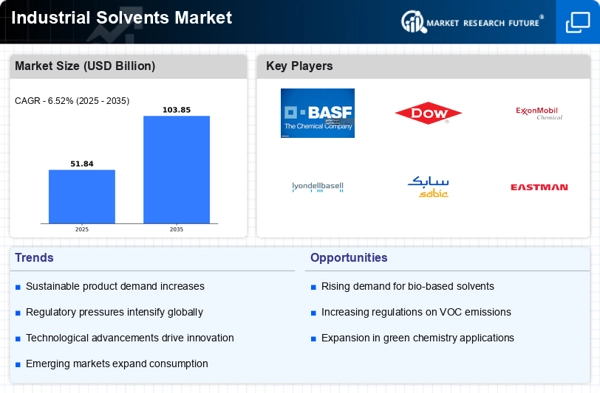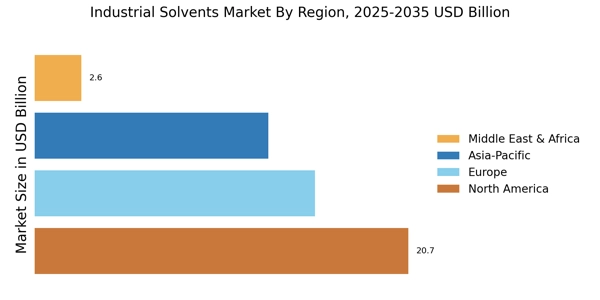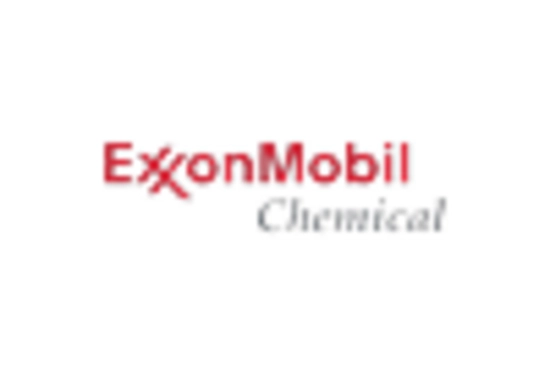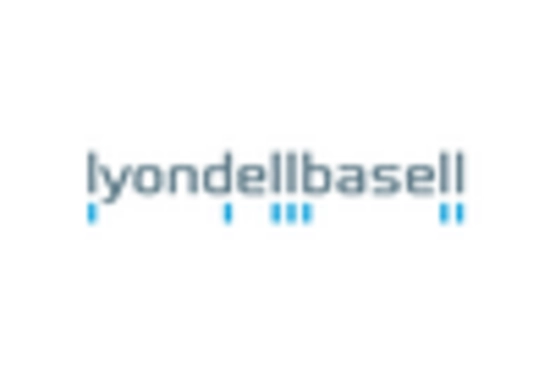Expansion of the Automotive Sector
The Industrial Solvents Market is experiencing growth due to the expansion of the automotive sector. As automotive manufacturers increasingly focus on lightweight materials and advanced coatings, the demand for specialized solvents is on the rise. In 2025, the automotive industry is expected to contribute significantly to the overall market growth, driven by innovations in vehicle design and manufacturing processes. Solvents are essential in various applications, including paint formulations and cleaning agents, which are critical for maintaining production efficiency. This trend suggests that the Industrial Solvents Market will continue to adapt to the specific needs of the automotive sector, potentially leading to the development of new solvent formulations tailored for automotive applications.
Rising Demand for Adhesives and Sealants
The Industrial Solvents Market is witnessing a rising demand for adhesives and sealants, which are integral to various manufacturing processes. The growth in industries such as construction, packaging, and electronics is driving this trend, as these sectors increasingly rely on high-performance adhesives for product assembly and durability. In 2025, the adhesives and sealants segment is anticipated to represent a significant portion of the market, reflecting the ongoing need for efficient bonding solutions. Solvents are crucial in the formulation of these products, influencing their performance and application characteristics. As the Industrial Solvents Market evolves, manufacturers may focus on developing solvent-based adhesives that meet the specific requirements of diverse applications, thereby enhancing market competitiveness.
Increasing Demand from Paints and Coatings
The Industrial Solvents Market experiences a notable surge in demand from the paints and coatings sector. This growth is primarily driven by the rising construction activities and the need for high-quality finishes in residential and commercial buildings. In 2025, the paints and coatings segment is projected to account for a substantial share of the market, reflecting a trend towards enhanced aesthetic appeal and durability. Solvents play a crucial role in the formulation of these products, ensuring optimal application and performance. Furthermore, the shift towards low-VOC and eco-friendly formulations is likely to influence the types of solvents utilized, thereby shaping the market dynamics. As manufacturers adapt to these changes, the Industrial Solvents Market is expected to evolve, presenting opportunities for innovation and sustainability.
Regulatory Compliance and Safety Standards
The Industrial Solvents Market is significantly impacted by stringent regulatory compliance and safety standards. Governments and regulatory bodies are increasingly enforcing regulations aimed at reducing the environmental impact of solvents, particularly those with high VOC content. This regulatory landscape compels manufacturers to innovate and develop safer, more sustainable solvent alternatives. In 2025, the market is likely to witness a shift towards compliant products that meet these evolving standards. Companies that proactively adapt to these regulations may gain a competitive edge, as consumers and industries prioritize safety and environmental responsibility. Consequently, the Industrial Solvents Market is poised for transformation, with a focus on developing solvents that align with both regulatory requirements and market expectations.
Technological Innovations in Solvent Production
Technological innovations in solvent production are reshaping the Industrial Solvents Market. Advances in chemical engineering and formulation technologies are enabling the development of more efficient and environmentally friendly solvents. In 2025, the market is likely to benefit from these innovations, as manufacturers seek to optimize production processes and reduce waste. The introduction of bio-based solvents and advanced recycling techniques may also play a pivotal role in this transformation. As companies invest in research and development, the Industrial Solvents Market is expected to witness a shift towards more sustainable practices, aligning with global trends towards environmental stewardship and resource efficiency.


















Leave a Comment